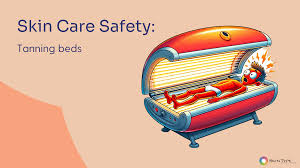
Skin care safety: The Science of Tanning Beds
Have you ever wondered why nobody uses tanning beds anymore? In a society where a sun-kissed glow is often celebrated, tanning beds used to be considered a popular tool for achieving that bronzed look year-round. However, the seemingly harmless pursuit of beauty via tanning beds carries significant health risks. This blog delves into the hazards associated with tanning beds, explains how they work, and offers insights into healthier alternatives for those seeking a tan. Before we get started, make sure to take the Baumann Skin Type Quiz to find out which products are best for your skin type!
Research shows that tanning beds can cause cancer
There is no safe way to use a tanning bed
Diligent care is needed to repair damage caused by tanning beds
What are tanning beds?
Tanning beds are devices that emit ultraviolet (UV) radiation to stimulate melanin production in the skin, mimicking the sun’s tanning effect. They are equipped with several fluorescent lamps that radiate UVA and, to a lesser extent, UVB rays, both of which contribute to the skin’s tanning process and unfortunately, to its damage.
How do tanning beds work?
Tanning beds operate by emitting ultraviolet (UV) radiation, primarily UVA and a smaller fraction of UVB rays, which are the same types of rays produced by the sun but at a much higher concentration and intensity in tanning devices. When UV rays penetrate the skin, they stimulate melanocytes, the cells responsible for producing melanin, which is the pigment that gives skin its color.
UVA rays have a longer wavelength that penetrates deeper into the skin, reaching the lower layers of the epidermis and dermis where melanocytes are located. UVA exposure causes the melanocytes to increase melanin production, resulting in the darkening of the skin known as a tan. This reaction is primarily a defense mechanism against UV damage, intended to protect the skin’s DNA from further UV-induced harm.
UVB rays, although less prevalent in tanning beds, are shorter in wavelength and primarily affect the more superficial layers of the skin. They are more directly responsible for sunburns but also contribute to melanin production by causing direct DNA damage, which signals the body to produce more melanin as a protective response.
The controlled environment of tanning beds allows for exposure to intense UV radiation in a short amount of time, increasing both the immediate and long-term risks of skin damage, premature aging, and skin cancers. Despite the ability to induce a tan, the UV exposure from tanning beds disrupts cellular processes and can lead to DNA mutations, underlining the significant risks associated with their use.
When did tanning beds become unpopular?
The popularity of tanning beds peaked in the late 20th century but began to decline as evidence based research linked their use to an increased risk of skin cancer and premature skin aging. Significant public health campaigns and stricter regulations also played crucial roles in diminishing their appeal.
Do tanning beds cause skin cancer?
Yes, tanning beds can cause skin cancer. Studies, including large-scale investigations like the Nurses’ Health Study II (10), have shown a clear link between tanning bed use and an elevated risk of basal cell carcinoma (BCC), squamous cell carcinoma (SCC), and melanoma. The risk is particularly high when tanning bed use starts in adolescence or young adulthood, highlighting a dose-response relationship where the risk increases with the frequency of use.
Other Dangers of Tanning Beds
Tanning beds age your skin, cause sun spots, and give you wrinkles! They also cause skin cancer.
Beyond skin cancer, tanning beds pose other health risks, such as:
Premature aging: UV radiation from tanning beds can lead to skin elasticity loss, resulting in premature wrinkles and leathery skin.
Eye damage: Exposure from tanning beds can increase the risk of cataracts and ocular melanoma if proper eye protection is not used.
Immune suppression: UV radiation from tanning beds can impair the skin’s immune function, increasing susceptibility to infections and reducing the effectiveness of vaccines.
How to Repair Your Skin If You Used a Tanning Bed
You will never be able to completely repair the skin damage that a tanning bed causes. However, if you make the mistake of using one, you can try these products to help skin protect itself.
Reducing skin damage from tanning beds involves several steps:
Hydration: Moisturizing the skin helps restore its barrier function.
Antioxidants: Products containing antioxidants like vitamin C or E can mitigate some of the oxidative damage caused by UV radiation.
Retinoids: These can improve skin texture and potentially reduce the risk of aging.
DNA Repair Enzymes: These ingredients are increasing in popularity, and may work to directly undo the some of the damage to your genes caused by radiation.
Regular dermatological check-ups: Monitoring for early signs of skin damage and cancer is crucial. This is very important because melanoma skin cancer is deadly.
Your best bet to reduce damage from a tanning bed is not to use one at all!
Here are some of my favorite products that can be used after a tanning bed:
Safe sun tanning
While no method of UV exposure is completely without risk, reducing UV exposure and protecting skin with broad-spectrum sunscreen, clothing, and seeking shade can lower the risks associated with sun tanning. You can find all our tips on safe sun tanning here! To be clear- tanning is not safe- but it is safer than a tanning bed. One thing is clear, tanning beds are among the least safe choices for tanning.
Are Spray Tans Safe?
Spray tans offer a UV-free alternative to traditional tanning beds, making them a safer option for achieving a bronzed look without the associated risks of UV radiation. The active ingredient in most spray tans is dihydroxyacetone (DHA), which interacts with the skin’s surface to darken it temporarily. While generally safe for external use, inhaling spray tan mist or applying it near the eyes should be avoided. It’s also worth noting that the sugar content in some spray tans can contribute to skin glycation, potentially accelerating the aging process if used excessively. Therefore, moderate use is recommended for maintaining skin health.
The self tanners in spray tans do not provide any appreciable amount of sun protection to your skin unless they are combined with sunscreens. The DHA does not protect skin the way melanin does.
Conclusion
Tanning beds offer a “quick fix” to achieving a sun-kissed glow but at a high cost to health, particularly in terms of increased skin cancer risk and accelerated skin aging. Alternatives like spray tans provide a safer option, although they should be used sparingly. For those curious about their skin type and its specific needs, consider taking the Baumann Skin Type quiz for personalized skincare advice. Remember, the safest tan is the one you don’t get from the sun or tanning beds. Embrace your natural skin tone or seek healthier alternatives to achieve your dream skin.


